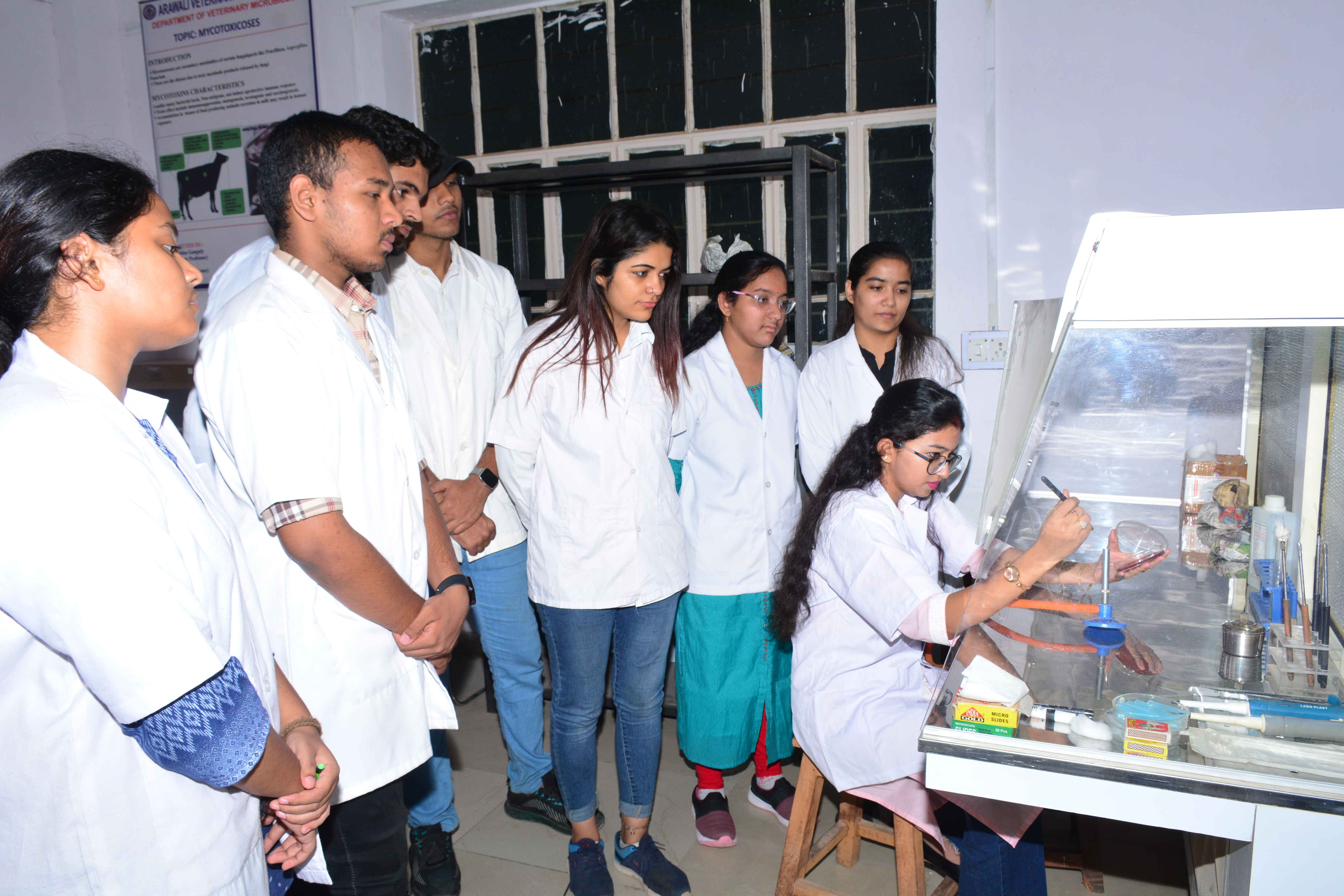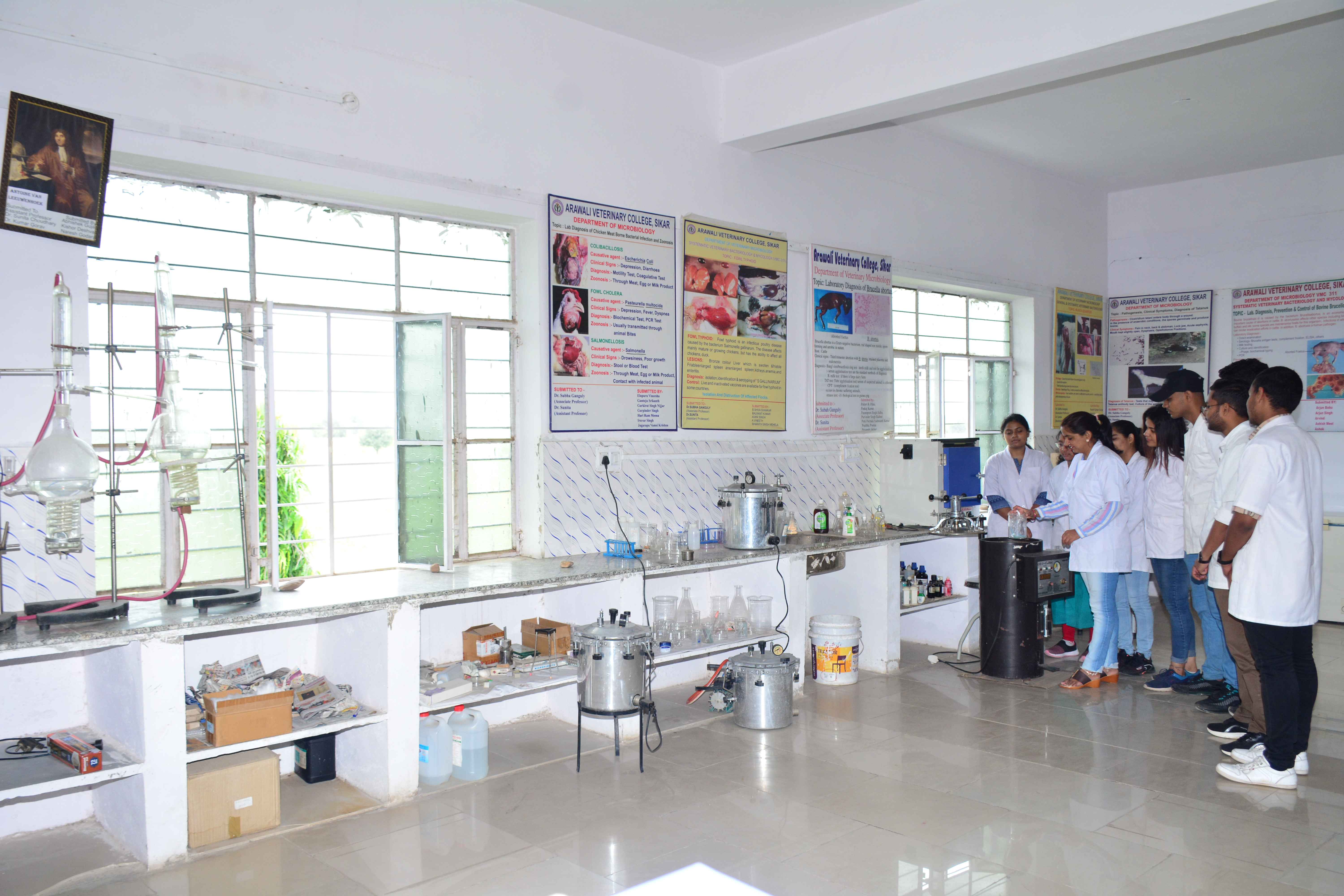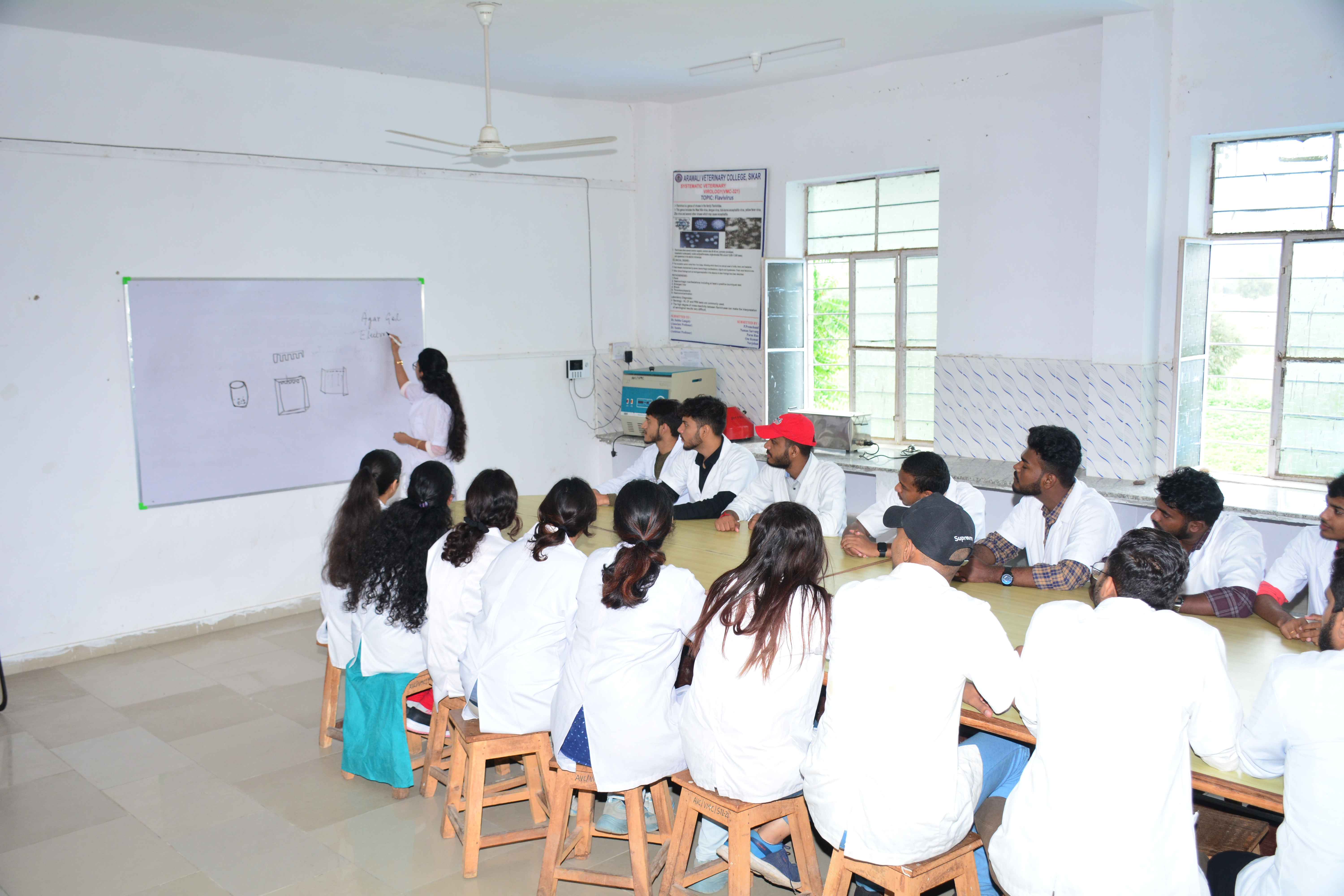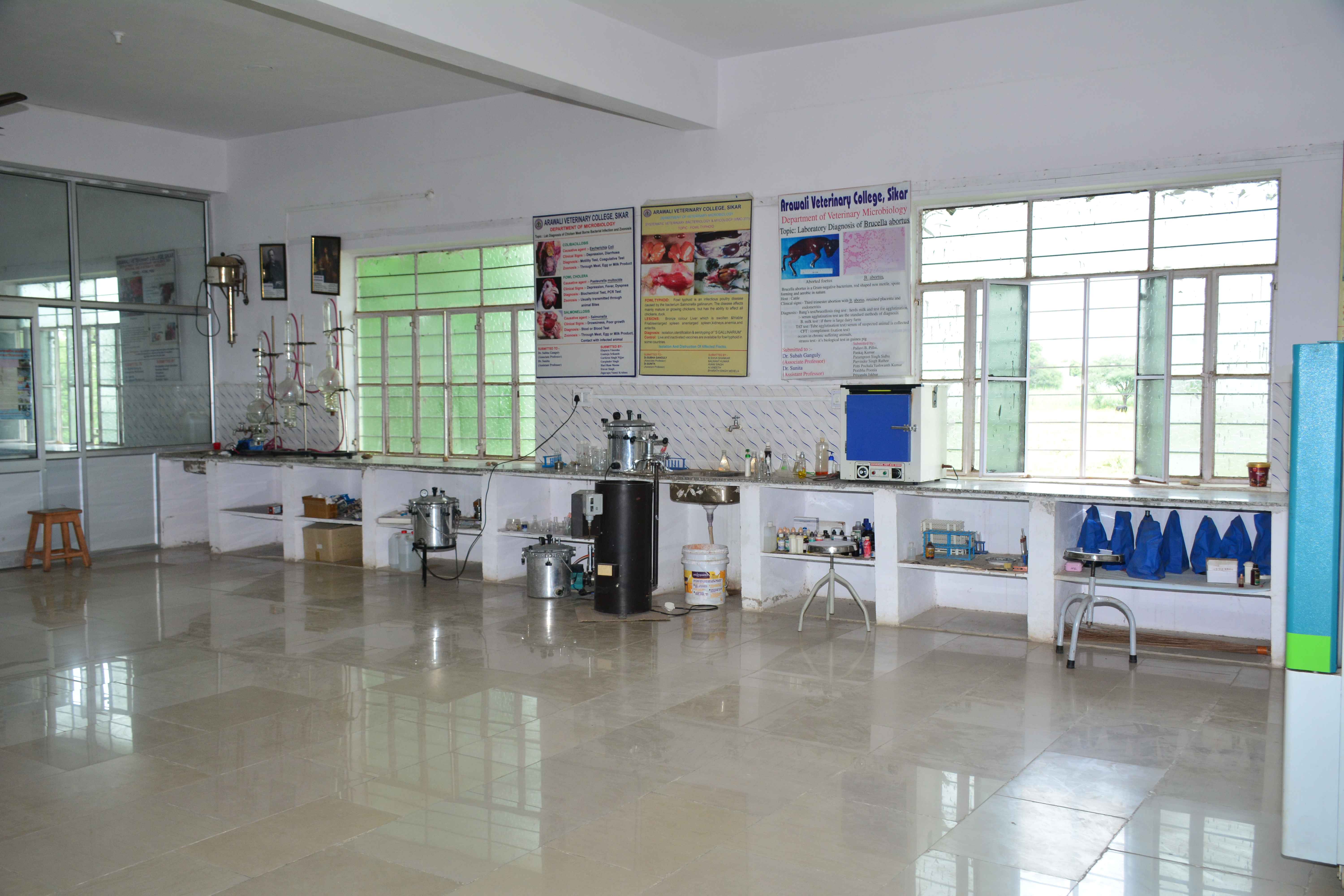



Department of Veterinary Microbiology: The department of microbiology offers courses in bacteriology, mycology, virology and immunology to teach characteristics of infective agents, pathogenesis and immune status of the infected animals. Practical training includes culture, isolation and characterization of infective agents and various serological diagnostic tests.
The Department has following sanctioned strength of Faculty:
Professor - 1
Associate Professor – 1
Assistant Professors – 2
S.No.
|
Name
|
Designation
|
Qualification
|
Service Period at AVC
|
Photo
|
Biodata
|
|
01
|
Dr. P. K. Prusty
|
Professor
|
B.V.Sc & AH, M.V.Sc and PhD
|
02.05.2022 to till Continue
|
 |
Biodata |
|
02
|
Dr. Rajesh Kumar Yadav
|
Associate Professor
|
B.V.Sc & AH, M.V.Sc
|
01.05.2025 to till Continue
|
 |
Biodata |
|
03
|
Dr. Anupriya
|
Assistant Professor
|
B.V.Sc & AH, M.V.Sc
|
Study Leave
|
 |
Biodata |
|
04
|
Dr. Apurva Gupta
|
Assistant Professor
|
B.V.Sc. & A.H., M.V.Sc.
|
Study Leave
|
|
|
|
05
|
Dr Muskan Koshal
|
Assistant Professor
|
B.V.Sc. & A.H., M.V.Sc.
|
22.08.2023 to 31.08.2025
|
|
|
|
06
|
Dr Sudhir Kumar Prajapati
|
Assistant Professor
|
B.V.Sc & AH, M.V.Sc and PhD
|
08.08.2025 to till Continue
|
|
Biodata |
COURSES AND SYLLABI
THEORY
UNIT-1 (GENERAL & SYSTEMATIC VETERINARY BACTERIOLOGY)
Introduction and history of Microbiology; Classification and nomenclature of bacteria; Microscopy and Micrometry; Bacterial stains and techniques; Structure and morphology of bacteria; Growth and nutritional requirement of aerobic and anaerobic bacteria; Normal, opportunistic and saprophytic bacterial flora: Types and sources of infection, method of transmission of infection. Pathogenicity, virulence, determinants of virulence, Epizootic and enzootic diseases, bacteremia, septicaemia and toxaemia, endotoxins, exotoxins, antitoxins, toxoids; Bacterial genetics (Mutation, Transformation, Transduction and Conjugation), plasmids and antibiotic resistance. Study of the following bacteria in relation to isolation, growth, cultural, morphological, biochemical and antigenic characteristics, epidemiology and pathogenesis, pathogenicity, diagnosis, prevention and control of bacterial diseases caused by following bacteria: Staphylococcus; Streptococcus; Corynebacterium, Trueperella,Rhodococcus; Listeria and Erysepelothrix; Bacillus; Mycobacterium; Clostridium, Actinomyces, Nocardia, Streptomyces and Dermatophilus; Family Enterobacteriaceae (E.coli, Klebsiella, Salmonella, Yersinia, Proteus); Pseudomonas and Burkholderia; Pasteurella, Mannheimia, Actinobacillus and Haemophilus, Brucella; Vibrio; Campylobacter; Bordetella and Moraxella; Gram negative anaerobes: Bacteriodes, Dichlobacteria and Fusobacterium; Leptospira and other Spirochaetes;Mycoplasma, Coxiella, Neorickettsia, Ehrlichia, Anaplasma, Rickettsia; Chlamydia and Chlamydophila Emerging, re-emerging and transboundry bacterial pathogens.
UNIT-2 (VETERINARY MYCOLOGY)
Introduction, classification, general properties of fungi; Growth and Reproduction of fungi; Study of following important pathogenic fungi in relation to their isolation, growth, morphological, cultural, biochemical and antigenic characteristics, epidemiology, pathogenesis, diagnosis and control of fungal diseases caused by following genera: Candida and Cryptococcus; Aspergillus; Penicillium; Dermatophytes and Malassezia; Dimorphic fungi, Rhinosporidium and Sporotrichum; Mycetoma and Zygomycetes; Mycotic mastitis and mycotic abortion; Mycotoxicoses
UNIT-3 (MICROBIAL BIOTECHNOLOGY)
Basic concepts and scope of Recombinant DNA technology; Gene cloning, Cloning vectors and expression vectors; Transformation and transfection; Southern, Northern and Western blotting; Bioinformatics, Gene banks; Application of molecular and biotechnological techniques: Polymerase chain reaction, Nucleic acid hybridization, DNA library, DNA sequencing and DNA fingerprinting; IPR. Ethics and regulatory issues in Animal Biotechnology.
UNIT-4 (VETERINARY IMMUNOLOGY AND SEROLOGY)
History of Immunology; Lymphoid organs, tissues and Cells: Types of Immunity; Antigens, hapten, epitope, Specificity, T dependent and T independent Antigens, heterophile Antigens, cross reacting Antigens, blood group Antigens, Mitogens and factors affecting immunogenicity; Adjuvants; Antibody: Structure, physiochemical properties and functions of various classes of immunoglobulins, Theories of antibody production; Hybridoma and monoclonal antibodies, Serological reactions. Major histocompatibility complex (MHC) structure, function and gene organization; Structure of BCR and TCR; Antigen processing and presentation; Complement system: activation pathways and biological consequences; Cytokines: general properties, major types and function; Hypersensitivity: classification and mechanism of induction; Autoimmunity; Immunotolerance; Concept of Immunity to Microbes, Vaccines and other biological.
UNIT-5 (GENERAL AND SYSTEMATIC VETERINARY VIROLOGY)
History of Virology; Introduction to viruses; Structure of Viruses; Classification of Viruses; Viral Replication; Genetic and Non-genetic viral interactions; Virus-Cell Interactions; Viral Pathogenesis, Oncogenesis, latency and immunopathology. Studies on General Properties, Antigens, Cultivation, Pathogenesis, Epidemiology, Clinical Signs, Diagnosis, Prevention and Control of following Viruses and Prions Causing Diseases in Livestock and Poultry: Birnaviridae: Infectious bursal disease virus; Reoviridae: Rotaviruses, Bluetongue virus, African horse sickness virus; Paramyxoviridae: Newcastle disease virus, Canine distemper virus, PPR virus; Rhabdoviridae: Rabies virus, Ephemeral fever virus, Bornaviridae: Borna virus. Orthomyxoviridae: Swine, Equine, Avian Influenza Viruses. Coronaviridae: Infectious Bronchitis virus, Transmissible gastroenteritis virus; Arterivirdae: Equine viral arteritis virus, Picornaviridae: FMD virus, Duck viral hepatitis virus; Caliciviridae: Feline calici Virus, Togaviridae: Equine encephalomyelitis viruses; Flaviviridae: Swine fever virus, BVD virus; Retroviridae: Visna or maedi virus, Equine infectious anemia virus, Lymphoid leucosis virus, Bovine leukemia virus. Poxviridae: Capripoxvirus, Avipoxvirus, Cowpoxvirus; Asfarviridae: African Swine Fever Virus; Herpesviridae: Bovine herpes viruses, Equine Herpes viruses, Infectious laryngotracheitis virus, Marek’s disease virus, Pseudorabies virus, Malignant Catarrhal Fever virus; Duck Plague virus, Adenoviridae: Infectious Canine Hepatitis virus, Egg Drop Syndrome virus, Fowl adenovirus, Papillomaviridae: Papillomatosis, Parvoviridae: Canine parvoviruses, Feline panleucopenia virus; Circoviridae: Chicken Anemia Virus: Prions: Scrapie, Bovine Spongiform Encephalopathy; Emerging, re-emerging and transboundry viruses and Viral Infections.
PRACTICAL
UNIT-1 (GENERAL AND SYSTEMATIC VETERINARY BACTERIOLOGY)
Orientation to bacteriology laboratory; Methods of sterilization and disinfection; Preparation of culture media for cultivation of aerobic and anaerobic bacteria; ethods of inoculation, Cultivation of aerobic and anaerobic bacteria; Isolation of bacteria in pure culture; Simple staining, Negative staining, Differential staining procedures of bacteria: Gram’s staining, Acid fast staining; Special staining procedures: Capsule and Spore staining; Bacterial motility; Culture sensitivity test; Outlines of collection, transportation and processing of samples for bacterial disease diagnosis. Characterization of Staphylococcus; Streptococcus; E. coli Salmonella; Klebsiella and Proteus; Pseudomonas; Pasteurella; Clostridium; Isolation and identification of bacteria from clinical cases of Mastitis, Abortions, Enteric, Respiratory and Pyogenic infections.
UNIT-2 (VETERINARY MYCOLOGY)
Outline of collection, transportation and processing of samples for fungal disease diagnosis, Preparation of culture media, Cultivation and slide culture technique of fungi; Cultural characteristics of fungi; Lactophenol cotton blue staining to study morphology of fungi; Culture sensitivity test of fungi; Diagnosis of Aspergillosis and Candidiasis; Demonstration of other important yeast, moulds and Dermatophytes
UNIT-3 (MICROBIAL BIOTECHNOLOGY)
Extraction and quantitation of nucleic acid; Plasmid isolation and plasmid profiling; Agarose gel electrophoresis for studying or diagnosis of nucleic acid of microbes; SDS PAGE electrophoresis for studying or diagnosis of proteins of microbes; Use of Multimedia and audio-visual aids for molecular biology aspects.
UNIT-4 (VETERINARY IMMUNOLOGY AND SEROLOGY)
Inoculations of lab animals, preparation of antigen, Raising of antisera, separation and preservation of serum, Concentration of Immunoglobulins, Agglutination tests: Plate, Tube, Haemagglutination, Precipitation test: Agar gel precipitation Test, Single radial immunodiffusion test, Immunoelectrophoresis, Cell mediated immune response (DTH), Enzyme linked immunosorbent assay (ELISA), Visit and appraisal of Veterinary biological institute.
UNIT-5 (GENERAL AND SYSTEMATIC VETERINARY VIROLOGY)
Orientation to a virology laboratory; Collection, preservation, transport of samples and their processing in virology laboratory; Isolation of viruses in laboratory animals or poultry or embryonated chicken eggs; Preparation of media and reagents for cell culture; Subculture and maintenance of continuous cell lines; Quantitation of cells by viable cell counts in a haemocytometer; Cryopreservation and recovery of cell cultures; Preparation of Primary cell culture (chicken embryo fibroblast or Lamb kidney); Demonstration of cytopathic effect by viruses in cell culture (Important virus isolates available in the department); Demonstration of Titration of virus by TCID50 and plaque assay in cell cultures*; Demonstration of neutralizing antibodies by serum neutralization test in cell cultures* ; Agar gel precipitation test for detection of virus infection*; Titration of Newcastle disease virus by haemagglutination test; Haemagglutination inhibition test for detection of antibodies to Newcastle disease virus; ELISA for detection of viral antigen and antibodies; Molecular techniques for viral disease diagnosis *Important virus isolates available in the department.
ANNUAL EXAMINATION
PAPERS UNITS MAXIMUM MARKS WEIGHTAGE
THEORY
Paper-I 1,2 and 3 100 20
Paper-II 4 and 5 100 20
PRACTICAL
Paper-I 1, 2and 3 60 20
Paper - II 4 an 5 60 20
INTERNAL ASSESSMENT 20